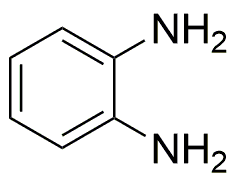1,2-Phenylenediamine is widely utilized in research focused on:
- Dyes and Pigments: This compound is a key ingredient in the production of azo dyes, which are widely used in textiles and food industries for their vibrant colors and stability.
- Pharmaceuticals: It serves as a building block in the synthesis of various pharmaceutical agents, including anti-cancer drugs, enhancing therapeutic efficacy and specificity.
- Polymer Chemistry: The chemical is used in the formulation of polyurethanes and epoxy resins, providing improved mechanical properties and resistance to heat and chemicals.
- Analytical Chemistry: It acts as a reagent in analytical methods for detecting nitro compounds, offering a reliable approach for environmental monitoring and safety assessments.
- Cosmetics: 1,2-Phenylenediamine is used in hair dyes and other cosmetic products, valued for its ability to provide long-lasting color while being effective in low concentrations.
General Information
Properties
Safety and Regulations
Applications
1,2-Phenylenediamine is widely utilized in research focused on:
- Dyes and Pigments: This compound is a key ingredient in the production of azo dyes, which are widely used in textiles and food industries for their vibrant colors and stability.
- Pharmaceuticals: It serves as a building block in the synthesis of various pharmaceutical agents, including anti-cancer drugs, enhancing therapeutic efficacy and specificity.
- Polymer Chemistry: The chemical is used in the formulation of polyurethanes and epoxy resins, providing improved mechanical properties and resistance to heat and chemicals.
- Analytical Chemistry: It acts as a reagent in analytical methods for detecting nitro compounds, offering a reliable approach for environmental monitoring and safety assessments.
- Cosmetics: 1,2-Phenylenediamine is used in hair dyes and other cosmetic products, valued for its ability to provide long-lasting color while being effective in low concentrations.
Documents
Safety Data Sheets (SDS)
The SDS provides comprehensive safety information on handling, storage, and disposal of the product.
Product Specification (PS)
The PS provides a comprehensive breakdown of the product’s properties, including chemical composition, physical state, purity, and storage requirements. It also details acceptable quality ranges and the product's intended applications.
Certificates of Analysis (COA)
Search for Certificates of Analysis (COA) by entering the products Lot Number. Lot and Batch Numbers can be found on a product’s label following the words ‘Lot’ or ‘Batch’.
*Catalog Number
*Lot Number
Certificates Of Origin (COO)
This COO confirms the country where the product was manufactured, and also details the materials and components used in it and whether it is derived from natural, synthetic, or other specific sources. This certificate may be required for customs, trade, and regulatory compliance.
*Catalog Number
*Lot Number
Safety Data Sheets (SDS)
The SDS provides comprehensive safety information on handling, storage, and disposal of the product.
DownloadProduct Specification (PS)
The PS provides a comprehensive breakdown of the product’s properties, including chemical composition, physical state, purity, and storage requirements. It also details acceptable quality ranges and the product's intended applications.
DownloadCertificates of Analysis (COA)
Search for Certificates of Analysis (COA) by entering the products Lot Number. Lot and Batch Numbers can be found on a product’s label following the words ‘Lot’ or ‘Batch’.
*Catalog Number
*Lot Number
Certificates Of Origin (COO)
This COO confirms the country where the product was manufactured, and also details the materials and components used in it and whether it is derived from natural, synthetic, or other specific sources. This certificate may be required for customs, trade, and regulatory compliance.


